4. Producing items
There is a window called the "Data"
window accessed from the "Windows" menu or by
typing cmd-d. We will use it now. In addition, we will display the
Control panel (see the "Windows" menu
or type cmd-=).
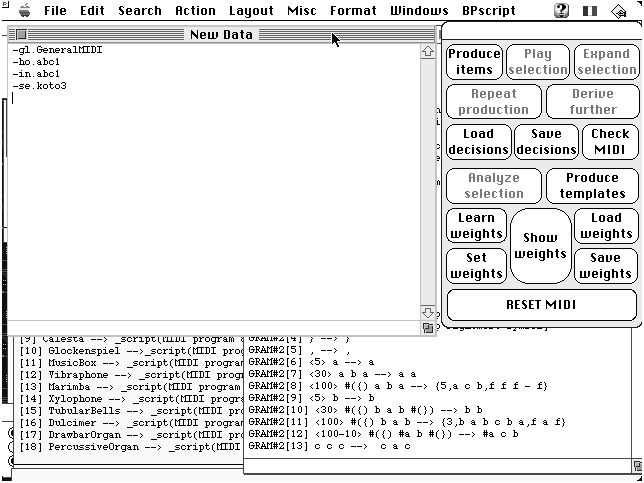 Fig.14
"Data" window and Control panel.Grammar and
glossary are visible behind these windows.
Fig.14
"Data" window and Control panel.Grammar and
glossary are visible behind these windows.
4.1 Listen to this one!
Click button "Produce items..." or type cmd-r. (Old-timers will remember the "Run"
command in Basic!). You see messages indicating that BP2 is computing the item.
(Don't hurry to read messages: there is a command in the "Windows"
menu recalling the latest 30 messages.) Eventually an item will be displayed.
Produce more items in the same way. The
sequence shown below is dependent on the random sequence generator, and may not
be the same on different machines.
 Fig.15 Four items have been produced by "-gr.koto3"
Fig.15 Four items have been produced by "-gr.koto3"These items are in text format, not
conventional musical score notation, but BP2 will later manage to convert them
to sounds on the basis of information contained in the "-mi.abc1"
sound-object file.
While BP2 is at work it may be
interrupted by keeping the mouse button down. A small window appears with "Resume" and "Stop" buttons allowing to
continue the job or abort it. "Resume" and "Stop" commands
appear in the "Action" menu as well. You may also type cmd-r or cmd-<period>.
During the interruption you are allowed to do almost anything, for example edit
the alphabet and grammar, change options, etc. This may be necessary if the
computation has become too slow and you want to understand why it is taking such
a long time: select for instance "Step-by-step produce" and then click
"Resume" or type cmd-r . (Note that options are related, therefore if
you select "Step-by-step produce" then "Display production"
will also be selected.) If the computation is looping you may modify the
subgrammar to find your way out. Understandably, BP2 might decide to recompile
the current grammar before resuming computation.
Because of this possibility of "doing
almost anything" while a process is interrupted, you may sometimes enter
into unpredicted situations in which BP2 is not able to resume the process
properly. Many unusual situations have already been encountered and are handled
by BP2, but it is virtually impossible to check all possible combinations.
Therefore if you are in the course of an important process it is safe to start
afresh before making radical changes.
Let us assume that a few items have been
produced in the "Data" window, as shown on Fig.15. Each item is
actually displayed as a single line, more precisely a "paragraph"
terminated with a carriage return. You may of course type items yourself if you
know the alphabet of terminal symbols recognised by the "-mi."
sound-object file.
For the next experiments it will be more
practical to use the Control panel (see Fig.14) than to pull down menus. Type
cmd-= or select "Control panel" in the "Windows" menu.
Select one or several item(s) with the
mouse. Click button "Play selection" or type cmd-p. First, BP2 loads
the "-mi."
sound-object file whose name is specified on top
of the "Alphabet" window. The "-mi.abc1" file is loaded
forever except if you make changes in the alphabet, in which case BP2 must look
for definitions of new sound-objects which the modified alphabet might be
refering to.
After a short while you see the
sound-object structure (the musical item)
displayed in the graphic window while the resulting sound is played on the MIDI
output.
Below is the graphic display of item
_vel(127) _volume(40) b b <<f>>
{5,a c b,f - f} a <<chik>> b <<sync>>
which was produced by this grammar.
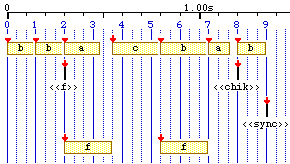 Fig.16 Graphic representation of sound-object structure:_vel(127) _volume(40)
b b <<f>> {5,a c b,f - f} a <<chik>> b <<sync>>
Fig.16 Graphic representation of sound-object structure:_vel(127) _volume(40)
b b <<f>> {5,a c b,f - f} a <<chik>> b <<sync>>
This graphic is a kind of musical score
with objects represented as rectangles. Background blue lines are
streaks of the
time structure and red arrows mark the
pivots of sound-objects. (See §2.1 or §3
of the reference manual; read Bel 1992a for a detailed presentation) A
tail-less arrow denotes a
relocatable object, i.e. one whose pivot may not
coincide with a time streak. If a sound-object is truncated the deleted part is
displayed with dotted lines.
Simple notes (see §1.3, §1.11)
are also represented with rectangles and with no pivot since they are
relocatable.
Note that you can modify colours by
selecting "Change colours" in the "Layout" menu, and save
the new options along with "-se.koto3" settings. Again, users of
black and white monitors should uncheck the "Use color" option in the
same menu.
A scale of physical time appears on top
of the window. Here the tempo was 400 beats per minute, therefore 400/60 = 6.66
beats per second.
You may change the graphic scale of
graphics by selecting "Graphic scale" in the "Misc"
menu. You must play the item again so that the effect of colour or graphic
scale changes become visible.
4.2 What's in a polymetric expression?
May be you liked the way this item
sounded (on a "Koto" patch of the D-50, or vibraphone in QuickTime
music) and want to understand its time structure. Click the "Data"
window (or type cmd-d) and select the item with the mouse. Then click button "Expand
display ". You get this:
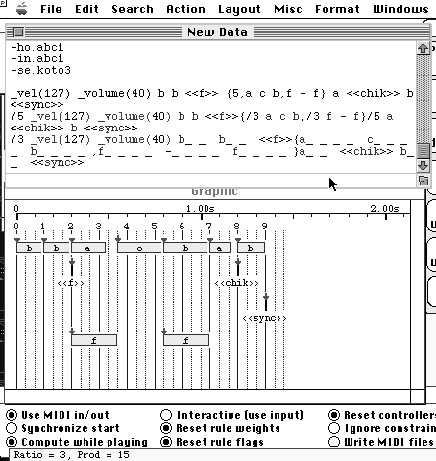 Fig.17 Expanding a polymetric expression
Fig.17 Expanding a polymetric expressionExpressions with curled brackets {} and
commas are called
polymetric expressions and represent polyphonic
sound-object structures. These expressions are
incomplete descriptions of the actual precedence relationships between
sound-objects and/or notes in the structure. BP2 is able to construct a
complete polymetric expression by adapting
tempos in superimposed sequences. (This process is explained in great detail in
Bel 1990a-b,1991,1992.) The expanded display shown Fig.17 is an outcome of the
expansion algorithm.
BP2 expands
any polymetric expression (including a simple
sequence) before making sounds. Once the expression has been expanded, the
following score-like
phase diagram is constructed:
 in which it is clear, for instance,
that the first occurrence of 'f' begins with the first occurrence of 'a'.
in which it is clear, for instance,
that the first occurrence of 'f' begins with the first occurrence of 'a'.
Symbols '_' prolongate sound-objects or
notes. For instance, the
symbolic duration of the first occurrence of 'b'
is three time units whereas the last occurrence of 'f' is five time units. (In
this particular example, a time unit is one third of a beat.)
Symbols <<f>>, <<chik>>
and <<sync>> represent
out-time sound-objects, i.e. objects with no
duration. Here for instance (from the information found in the "-mi.abc1"
file), <<f>> will be a NoteOn on key F4 followed immediately with a
NoteOff. <<chik>> is a chord plucked in the same way. It is only
audible if the NoteOff instruction does not suppress sound immediately.
Therefore we used a "plucked string" patch.
Out-time sound-object <<sync>>
produces a C5 on MIDI channel 15 that does not make any sound but may be used to
synchronise another BP2 running on the same MIDI network (see §6.4).
Performance controls
_vel(127) and _volume(40) are attached to the next
object or silence appearing in the same sequence, and are not displayed on
graphics. Remember that you can attach very subtle variations of all MIDI
parameters, notably pitchbend, modulation, aftertouch, to any structure of
sound-object or/and simple notes. (See §1.4-10 regarding performance
controls.)
Many polymetric expressions are found in project "-gr.polyphony1".
You may select only part of the item
(even a single terminal symbol) and listen to the way it sounds (type cmd-p).
Try to figure out the difference between "striated" and "smooth"
time by carefully looking at the graphics these different settings generate.
(See §9 regarding smooth time.)
4.3 The "Time base" dialog
To change the metronome value, type cmd-t. The "
Time base
" and "
Metronome" dialogs are displayed (see Fig.18).
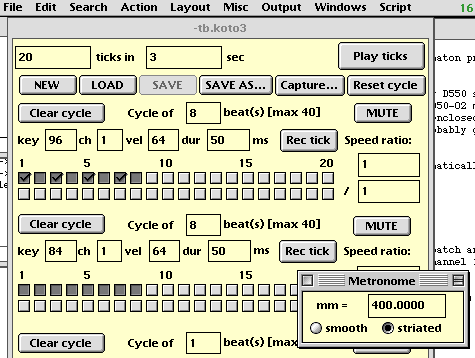 Fig.18 "Time base"and "Metronom"
dialogs
Fig.18 "Time base"and "Metronom"
dialogs
There are two ways of adjusting the
clock. The "
Metronom" dialog deals with conventional
metronome settings, i.e. "mm = 400" means 400 ticks per minute. You
may change this value, for instance, to 345.08. Changes are reflected in the "
Time base
" dialog. Now it tells "8627 ticks in
1500 seconds", which actually means the same as "mm = 345.08".
If you need to set the time base accurately, type directly the numbers of ticks
and/or seconds. Whenever you change values, BP2 finds the simplest integer
numbers yielding the expected integer ratio. The "Metronom" dialog
may display a rounded value which will not affect accuracy since BP2 actually
uses the integer ratio displayed on the "Time base" dialog.
A very accurate clock is needed to
superimpose BP2 items on a given (digitized) sound track. In addition,
synchronisation tags (see §6.6) or Apple Events (§6.7) make it
possible to start items on precise dates determined by the environment.
The "Time base" dialog contains boxes allowing the definition of
three independent cycles
that produce
ticks on marked beats. When "Play ticks" is checked, ticks become audible. Ticks may be
mapped to any MIDI key, channel and velocity. For each cycle, first adjust the
cycle duration (1 to 40 beats), then check the boxes of all beats that need to
be stressed by a tick. Each cycle may run at a speed differing from that of the
basic clock if its speed ratio is not 1/1. A typical example is given in the
time base saved as "-tb.slowshift" which may
be opened (cmd-o) when the "Time base" dialog
is in front.
It is possible to define each tick of
the time base individually. Click any square of a tick cycle with the 'option'
key down to display the "
Tick settings
" dialog (Fig.19).
 Fig.19 "Tick settings" dialog
Fig.19 "Tick settings" dialogThe ON/OFF button determines whether the
beat should be audible. If "Use default settings" is checked then the
tick will be heard on the default channel, key and velocity of its cycle. If "Use
special settings" is checked, then these parameters are specified
individually as shown Fig.19. The "Capture settings"
button makes it possible to pick up these parameters from a MIDI device. It's a
good idea to send ticks to a MIDI sampler with
percussive or fancy sounds.
A tick cycle may be captured as a MIDI
stream and pasted to a sound-object prototype (see §2.3.3). Ultimately, if
the sound-object is played alone it can further be saved to a MIDI file (see §14.1). This is a good trick to use tick cycles
created by BP2 with other MIDI software.
The time base continues ticking, if
instructed to do so, while BP2 is improvising items. You may check this with
examples contained in "-da.tryTicks". Note
that in
smooth time (see §9) beats may become
irregular, depending on time streaks created by the musical item. Try "-gr.tryTimePatterns" to hear the difference. These superimposed ticks
are neither saved in MIDI files nor interpreted as Csound events.
Different settings of the time base have
been saved as -tb.<name> files representing the
most popular
talas of North Indian classical music.
The time base allows an
accurate transcription of durations when notes
are entered from the MIDI keyboard (typing cmd-j, see §1.5). When "Play
ticks" is checked, durations are transcribed
following the
period notation (see §1.12.1).
4.4 Blowing memory on fractals...
Instead of listening to a selected item,
you may copy and paste parts of it. For instance, select the whole item shown
on Fig.16, type cmd-c or select "Copy" in the "Edit" menu,
then select the first occurrence of 'a' and type cmd-v or select "Paste".
In this way, you replace 'a' with the whole item "b b <<f>>
{5, a c b, f - f} ...". The resulting performance is the following:
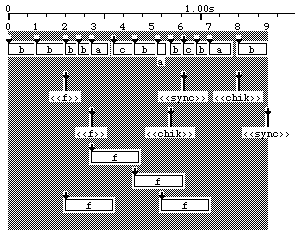 Fig.20 A "fractal" musical item
Fig.20 A "fractal" musical item
You can hear (and see) that the overall
duration of the item is unchanged although it has become more complex. Now,
time units (for the desired accuracy) have become so small that streaks appear
as a grey background. Fractal fanatics may repeat the operation several times
or figure out a self-imbedding grammar doing it automatically. Indeed, you'll
end up blowing the computer's memory, so be careful to save windows before
producing items and try to set a computation limit using
dynamic weights (§4.6 of reference manual),
flags in programmed grammars (§11 infra) or limited buffer size (§4.7
infra). Quantization (see §6 of reference manual) is also strongly
recommended in this context.
You can type cmd-p while a string
containing terminal symbols and variables is selected in any window. For
instance, bring to front the alphabet window and listen to sound-objects 'a',
'b', 'c', etc., separately. Then bring the grammar window to front and select
any string containing terminal symbols. If variables are found, the selection
is taken as a start string in production mode.
4.5 Victor Hugo against Darius Milhaud
You will appreciate BP2's ability to
produce intricate
polyrhythmic patterns by playing item produced
by "-gr.Djinns" with percussive sounds (e.g.
Roland's "C-54 percussion set 1"). The piece was created to
synchronise the recitation of Victor Hugo's poem "
Les Djinns
" with the opening section of "
La Création du Monde
" by Darius Milhaud (EMI CDC-7 47845 2) in Andréine Bel's
choreographic work for
Collège des Prêcheurs
and
Conservatoire Darius Milhaud
(Aix-en-Provence, 1992). We found that the meaning of the poem would
coincide with particular events in the musical piece. Then we calculated a
time-base value fitting the two tracks together: setting 1000 beats in exactly
1578 seconds was possible since BP2 does not round integer ratios.
Poem "
Les Djinns
" is built on verses with variable meters: 2/2/2/2/3/3/3/3/4/4/4/4
...up to 10/10/10/10 --except 9/9/9/9-- and then decreasing (see appendix).
We decided that every verse should have
the same duration marked by 16 beats with a stronger first beat. The result is
a polyrhythmic piece with one instrument showing beats at a fixed speed and
another one playing ticks at variable speeds. Listening to variable parts made
it possible for children to recite the poem at the expected tempi.
The grammar below shows how the piece
was produced. It has 15 sections labelled "A2", "A3", etc.
Each section puts together a fixed motive "M" and a variable motive "T16",
"T24", etc. Here, "T16" stands for 16 ticks played as note "do4".
Fixed motive "M" is a string of alternated "do2" and "do3"
with a stronger beat in the beginning, where "sib5" is played together
with "do2".
-se.Djinns
ORD
S --> A2 A3 A4 A5 A6 A7 A8
A10 A8 A7 A6 A5 A4 A3 A2
-------------------------
SUB1
A2 --> {M,T16}
A3 --> {M,T24}
A4 --> {M,T32}
A5 --> {M,T40}
A6 --> {M,T48}
A7 --> {M,T56}
A8 --> {M,T64}
A10 --> {M,T80}
-------------------------
ORD
T16 --> T8 T8
T24 --> T16 T8
T32 --> T16 T16
T40 --> T32 T8
T48 --> T32 T16
T56 --> T48 T8
T64 --> T32 T32
T80 --> T40 T40
T8 --> Tik Tik Tik Tik Tik
Tik Tik Tik
-------------------------
SUB1
M --> {1,do2,sib5} do3 do2
do3 do2 do3 do2 do3 do2 do3 do2 do3 do2 do3 do2 do3
Tik --> do4
Fig.21 A grammar for reciting
poem "Les Djinns"
Below is a graphic example of the output
of "A6 A7".
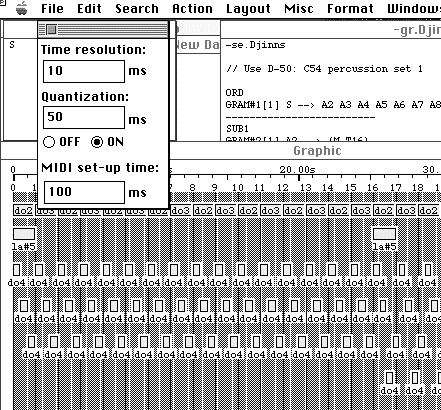 Fig.22
The "A6 A7" tick pattern in "Les Djinns"
Fig.22
The "A6 A7" tick pattern in "Les Djinns"
If only variable parts must be heard
then regular beats "do2" and "do3" may be replaced with
silences.
It is easy to figure out that the full
piece would require an excessively large phase diagram
(more than 200,000 columns) because it is based on the lowest common multiple of
2, 3, 4, ... 10. Therefore it can played only if
quantization is set to a reasonable value (see §6
of reference manual). We found that musicians were be satisfied with a 50
millisecond quantization even though deviations of ±50ms were still
noticeable in the "A7" part. With this setting, computation requires a
2 Mbyte memory partition for BP2 and it takes a couple of minutes on a Mac IIci,
so be patient if you can't borrow your rich neighbour's PowerMac...
You may use almost the same grammar with
syllabi of the poem stored on a sampler and triggered by appropriate keys. I
prefer live children's voices...
4.6 Graphic scale and time accuracy
Fig.23 shows a few dialogs activated by
the "Misc" menu.
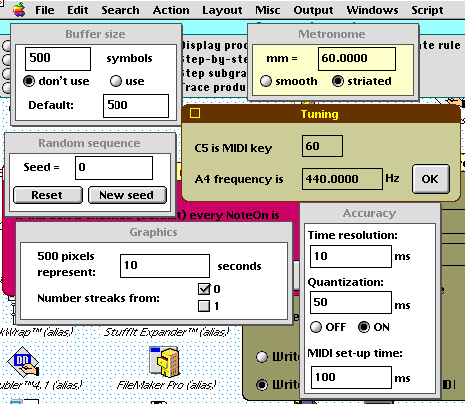 Fig.23 Graphic scale, time accuracy, etc.
Fig.23 Graphic scale, time accuracy, etc.
Time accuracy is
set in the "Accuracy" dialog.
Time resolution is the shortest significant time
interval, i.e. the resolution of the in-built MIDI driver. Its default value is
10 milliseconds, but you might want to change it (down to 1 millisecond).
Because of the inaccuracy of MIDI devices, however, time resolution less than
10ms is rather illusory.
Note that timings in the Csound output
(see §17) are not influenced by the time resolution.
Internal computations use 1ms
resolution. BP2's clock uses
long integer
numbers in range 0..2
31. This allows you to handle items lasting up to:
0.001 x 2
31
= 2,147,483 seconds = about 24 days...
The "Accuracy" dialog also
displays the setting of
quantization (see reference manual §6). "
MIDI set-up time" is an estimation of the
time needed by MIDI codes to transit through the MIDI driver. A 100ms value is
safe. Small values sometimes lead to incorrect timings in the beginning of
items.
4.7 Buffer size
Normally BP2 takes care of the size of
the
work string (the item being computed) and
expands its work space when necessary. You may want to control it, notably when
using a length-increasing grammar. Dialog "Buffer size" (see Fig.23)
displays the current buffer size and the default one assigned when computation
starts. Suppose that you do not want to produce a string longer than 750
symbols. Type "750" in the upper field and any
equal or smaller
value in the default field, then select "use". Now BP2 computes
items until the length of the work string reaches 750 symbols, then it prompts
you to decide whether you want to stop or continue (expanding the current work
space).
In the "-gr.Mozart" project (see §5.4 infra), default buffer size
is set to 500 symbols but all items need more space. Therefore, BP2 is forced
to expand its space for the work string the first time it produces an item. It
does so without asking any permission because the "Don't stop" option is on. The new value is stored into dialog "Buffer
size". (Buffer expansion is done stepwise: size is
recurrently multiplied by 3/2.)
Setting a very high default value
reduces the memory available for other operations. Setting a too small one
reduces speed during the first computation, as BP2 needs to resize the work
string buffer more often.
A typical application of buffer size
limitation is project "-gr.cloches1", an
extension of project "-gr.bells" described in §4.12
of the reference manual. Here, computation will not stop unless the buffer size
limit is reached, or the mouse is clicked.
Incidentally, project "-gr.cloches1" uses a homomorphism labelled
"TR" (see the alphabet window) similar to a transposition, although more complex. This may give you ideas for
homomorphisms generating tonal transformations in a more complex way than the "_transpose()" performance control. (Keep in mind that the same
note may be played by different sound-objects.)
4.8 The "Tuning" dialog
Fig.23 displays a dialog named "Tuning"
accessible from the "Misc" menu. By default, the middle C note ("C4"
in English, "do3" in French, "sa4" in Indian notation) is
assigned key 60, and the "A4" frequency is 440Hz.
See §1.11 the convention on octave
numbering.
There was a confusion in previous
versions of BP2 (until 2.6.2). Middle C had been assigned to C5 because of an
error inherited from another music software, which went unnoticed until the
Csound interface was checked. Therefore old projects may play one octave too
high. To compensate this, assign middle C to key 48, and set A4 to 220Hz if you
are using Csound. Change values in the "Tuning" dialog and save the
project settings.
In a forthcoming version a transposition
tool will be available to modify otave numbers in grammar, data and alphabet
windows.
The
diapason frequency of BP2 is used only for
producing Csound scores with instruments that take the "cps (Hz)" format as a pitch parameter.







 in which it is clear, for instance,
that the first occurrence of 'f' begins with the first occurrence of 'a'.
in which it is clear, for instance,
that the first occurrence of 'f' begins with the first occurrence of 'a'.



